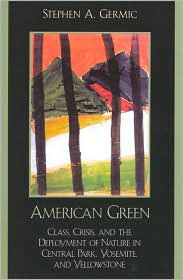American Green: Class, Crisis, and the Deployment of Nature in Central Park, Yosemite, and Yellowstone
In this work of interdisciplinary scholarship, Stephen A. Germic reveals how America's first parks, both urban and "wilderness," were created and organized to mitigate the most threatening social and economic crises in the nineteenth century outside of the Civil War. Germic analyzes the intentionally disguised relationship between the constructed "nature" of Central Park, Yosemite, and Yellowstone and the expanding but crisis-prone capitalist state. American Green demonstrates how the fundamental function of these parks was economic and political—in the service of maintaining a consensus regarding national identity. The organization and control of "natural" space, Germic argues, is inseparable from its function as a capitalist instrument. This instrumentalism served not only to define, constitute, and segregate social groups, but also to promote racial and ethnic identifications above those based on class interest. Providing a fresh insight into United States labor, cultural and environmental history, this book is an important contribution to our understanding of American parks and the complex meaning of American public space.
1112283674
American Green: Class, Crisis, and the Deployment of Nature in Central Park, Yosemite, and Yellowstone
In this work of interdisciplinary scholarship, Stephen A. Germic reveals how America's first parks, both urban and "wilderness," were created and organized to mitigate the most threatening social and economic crises in the nineteenth century outside of the Civil War. Germic analyzes the intentionally disguised relationship between the constructed "nature" of Central Park, Yosemite, and Yellowstone and the expanding but crisis-prone capitalist state. American Green demonstrates how the fundamental function of these parks was economic and political—in the service of maintaining a consensus regarding national identity. The organization and control of "natural" space, Germic argues, is inseparable from its function as a capitalist instrument. This instrumentalism served not only to define, constitute, and segregate social groups, but also to promote racial and ethnic identifications above those based on class interest. Providing a fresh insight into United States labor, cultural and environmental history, this book is an important contribution to our understanding of American parks and the complex meaning of American public space.
53.99
In Stock
5
1

American Green: Class, Crisis, and the Deployment of Nature in Central Park, Yosemite, and Yellowstone
160
American Green: Class, Crisis, and the Deployment of Nature in Central Park, Yosemite, and Yellowstone
160Paperback(New Edition)
$53.99
53.99
In Stock

Product Details
| ISBN-13: | 9780739102299 |
|---|---|
| Publisher: | Lexington Books |
| Publication date: | 05/25/2001 |
| Edition description: | New Edition |
| Pages: | 160 |
| Product dimensions: | 5.92(w) x 9.02(h) x 0.36(d) |
About the Author
From the B&N Reads Blog
